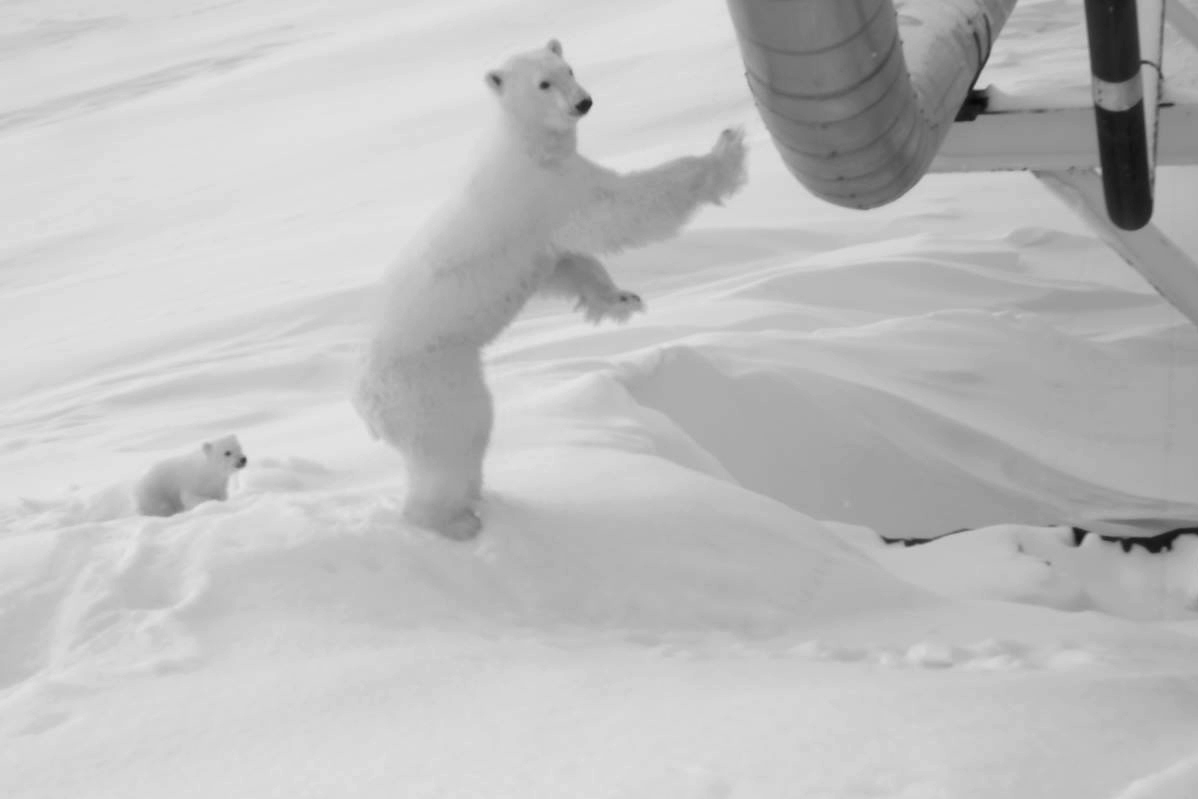A new polar bear denning study is a mixed bag for Alaska’s oil industry
The study shows existing restrictions do a good job of protecting known dens — but current methods miss many dens, with dangerous consequences.
Polar bears on Alaska’s North Slope are not easily dislodged from their snowy dens by oil-industrial noise, according to a new study. That finding is offers a mixed verdict on industry activities.
Decades of observations on the Arctic terrain shared by bears and industry showed that only 8 percent of bears abandoned their dens when they were disturbed by human activity, according to the study, by scientists from Brigham Young University and Polar Bears International and published in the journal Arctic.
The dens, which females dig in the snow and use for months to give birth to and nurture their cubs, are important sanctuaries that are closely held except in extreme circumstances, the study’s lead author said.
“It’s our belief that they’ll literally stay in there until they’re about to be run over or are run over,” said lead author Wesley Larson, a bear biologist at Brigham Young. “To leave their dens for them is to basically abandon any cubs that are born or, if they haven’t had cubs, just to give up.”
The problem with the bears’ strong fidelity to their dens is it puts them at risk for such a fate, the study found.
While the study affirms the effectiveness of the current rule requiring a one-mile buffer around known polar-bear dens, a large percentage of polar bear dens go undetected and are thus at sites unknown to the oil industry.
[Denning polar bears need better protection from Alaska oil development, scientists say]
The aerial thermal-detection methods used by the industry miss more than half of the dens, said a previous study by some of the same authors. Many of the dens are too deep below the snow surface, making them hard to detect by forward-looking infrared imagery, or FLIR, as employed by industry. A major shortcoming in use of FLIR to detect bears is the effect of wind, which disperses the heat signal that the surveys are supposed to capture — and many of the industry’s surveys are conducted during the North Slope’s frequent windy periods, that study found.
For the Southern Beaufort Sea polar bear population, which has been hard-hit by changes to its habitat, the threat of industrial disturbances to denning polar bears is heightened by expanded oil operations on the North Slope.
As sea ice retreats, more polar bears have taken to land sites for denning, including sites in the coastal plain of the Arctic National Wildlife Refuge, an area where the Trump administration is poised to authorize oil leasing and drilling. A previously proposed plan to authorize 3-D seismic surveys on the coastal plain, a program that would send massive “thumper” vehicles crisscrossing the terrain, shooting sonic waves into the earth to map out geologic structures, posed grave threats to polar bears and to the natural resources of the region in general, a group of University of Alaska Fairbanks scientists warned.
That seismic-survey plan is now on hold, and the Trump administration has yet to schedule an ANWR lease sale. But the administration last month released its plan to vastly expand oil activities on the other side of the North Slope, in the National Petroleum Reserve in Alaska.

Larson said the new study gives the oil industry some credit for its current bear-protection practices. An important finding was the validation of the existing protective buffer.
“That buffer does seem to be sufficient to achieve bear protections,” Larson said.
But it provides some cautionary lessons as well.
Noise can cause stress that falls short of den abandonment, and such stress can make it harder for mother bears to raise their cubs, Larson said.
To analyze the effects of industry noise on denning bears, the study authors used the same on-the-ground information that produced the study about FLIR den-location effectiveness. That was data collected for decades across the central North Slope, the area where oil activity has been established. The dataset combines in-person observations by scientists on the landscape and images collected by cameras installed in the region. Den locations were identified by radio-collar tracking, analysis of terrain and its suitability for denning and other methods.
To get to the results, the authors combed through all the records of all human-bear interactions over the 1975-to-2017 dataset period. Bears’ responses — or lack of them — were analyzed and disturbances were ranked from low-intensity to high-intensity stressors.
The most stress, the scientists found, came from low-flying aircraft. Exposure to noise from low-flying planes or helicopters resulted in a 22.6 percent probability of den abandonment in the study area, they found. Even those bears that did not abandon dens responded to the aircraft with rapid movements or heightened vigilance, the study found.
Small machinery, in contrast, was not much of a problem for the denning bears, the study found. In more than half the cases, the bears had no response, it said.
”It’s a good thing that any little disturbance isn’t scaring them out of their dens,” he said. That includes travel by snowmobile, which is important to the region’s Indigenous people, he said.
The lesson of the study is that current protections should stay in place, den-detection surveys should be improved and extra precautions are needed when traveling with noisy equipment over the landscape or flying low in the air above, Larson said. The first item may be a challenge in the current political environment, he said.
“With the current administration, with kind of the way things are going, there is this pushback of rules that are seen as too restrictive,” he said.


